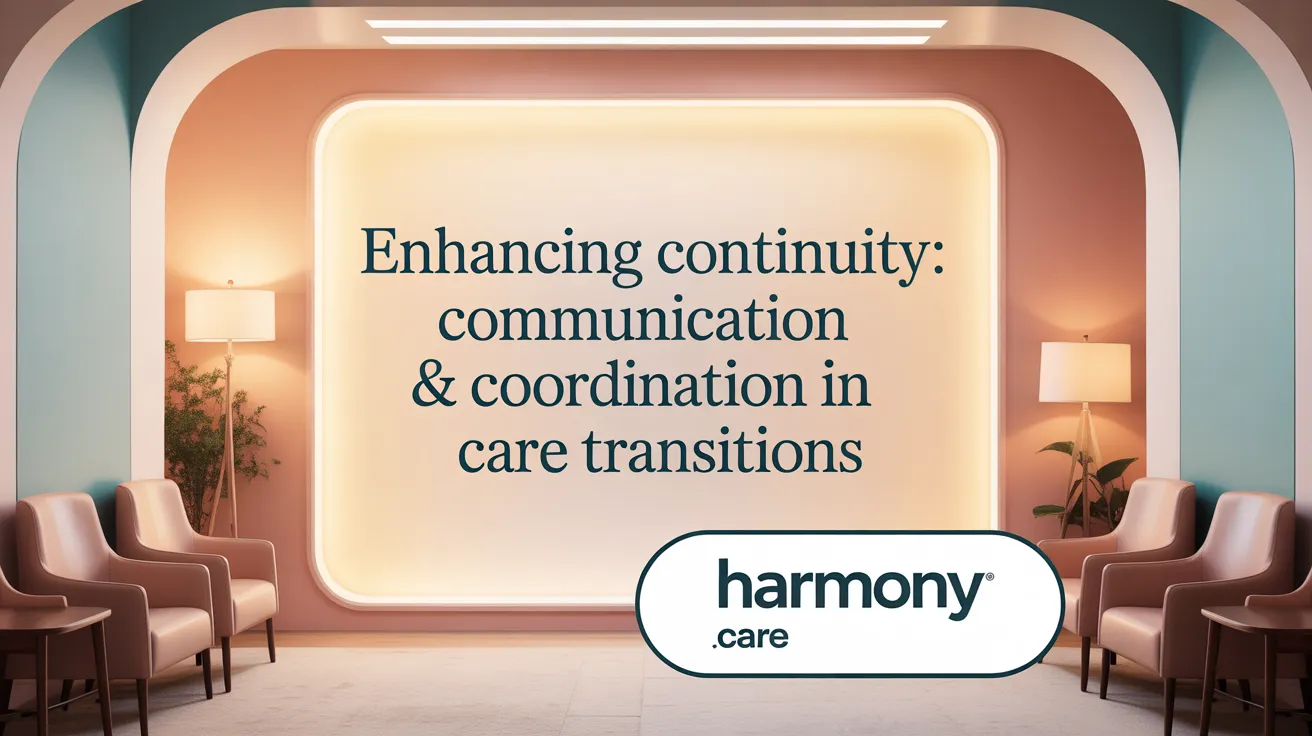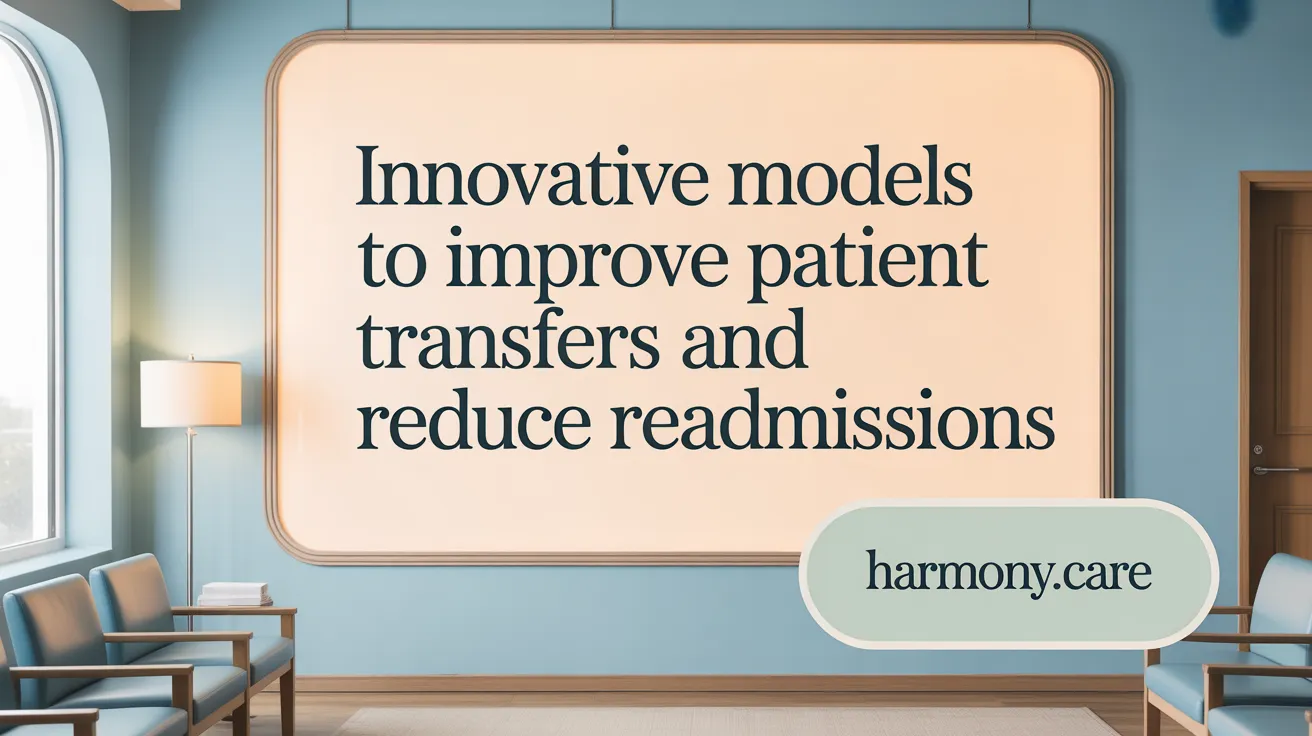Understanding Care Transitions and Their Critical Role in Patient Safety
Transitions of care mark pivotal moments within the healthcare continuum, particularly the movement of patients from hospital settings back to their homes. These transitions are fraught with potential risks, especially for vulnerable populations such as older adults managing multiple chronic conditions. Effective management during this process is vital to maintain continuity, reduce adverse events, and prevent costly readmissions. This article explores comprehensive strategies, models, and innovations designed to close care gaps and enhance safety during these crucial phases.
Defining Care Transitions and Identifying Common Gaps

What is transition of care in healthcare?
Transition of care in healthcare refers to the movement of patients between different care settings, providers, or levels of care as their health needs and conditions change. It involves coordinated actions to ensure continuity, safety, and quality of care during these transitions, such as from hospital to home or between primary and specialty care.
Effective transition processes include the use of comprehensive care plans, timely communication, education, medication reconciliation, and the transfer of relevant health information through standardized formats. The goal is to prevent adverse outcomes, reduce readmissions, and improve patient experience and health outcomes. Transitional care emphasizes that proper management during these movements is essential for maintaining seamless and safe patient care across the healthcare system.
What are the common gaps in patient transitions of care from hospital to home?
Several challenges hinder smooth hospital-to-home transitions. A primary issue is the lack of comprehensive communication between healthcare providers and patients. This can lead to misunderstandings about treatment instructions, medication management, and follow-up plans.
Incomplete or inaccurate transfer of medical information poses significant risks, including medication errors, missed outpatient appointments, and delays in recognizing health deterioration. Patients and families often report receiving insufficient education about self-care, warning signs, and whom to contact if issues arise.
Moreover, limited access to essential services such as home health support, transportation, or community resources can create barriers to effective recovery. The absence of a dedicated care coordinator or responsible person to oversee the process results in fragmentation of care and can increase the likelihood of preventable complications and readmissions.
Challenges faced by vulnerable populations
Vulnerable groups, including older adults and socioeconomically disadvantaged individuals, face heightened risks during care transitions. They are more likely to encounter social determinants of health such as transportation issues, financial constraints, and limited social support.
Older adults often manage multiple medical conditions and medications, which complicate their transition. Disparities are evident, with racial minorities, like Black patients, experiencing fewer follow-up visits and less access to postdischarge resources. These challenges amplify risks, making targeted intervention and tailored support essential to improve outcomes.
| Aspect | Challenges | Impact | Additional Details |
|---|---|---|---|
| Communication | Incomplete or delayed information transfer | Medication errors, missed follow-up | Use of inconsistent discharge summaries |
| Education | Insufficient patient and caregiver info | Poor self-management, confusion | Limited understanding of warning signs |
| Access & Support | Transportation, social needs | Missed appointments, unmet health needs | Social determinants hinder recovery |
| Coordination | Lack of dedicated care roles | Fragmented care, adverse events | Need for effective care management models |
Understanding and addressing these gaps through improved communication strategies, patient engagement, and systemic coordination are vital steps toward safer, more effective care transitions.
Key Strategies and Best Practices to Close Care Gaps

How can healthcare providers close care gaps during hospital-to-home transitions?
Closing care gaps during the critical transition from hospital to home requires a multifaceted approach centered on comprehensive care management. Programs that systematically identify and address unmet needs—guided by evidence-based protocols—are essential. These include thorough screenings and assessments that reveal overlooked services such as vaccinations, medication management, and chronic illness follow-up.
A vital component is active patient and caregiver engagement. Educating families using techniques like teach-back ensures they understand care plans, medications, and warning signs. Consistent communication among all healthcare providers—facilitated by standardized transfer documentation and health IT systems—helps prevent information silos.
Addressing social factors such as transportation, housing, and financial barriers is also crucial. Connecting patients with community resources reduces access issues that could lead to rehospitalizations.
Preventive measures like scheduled wellness visits, timely follow-ups, and use of care coordination tools contribute to better health outcomes. Regular monitoring, whether via telehealth or home visits, enables early intervention when issues arise, ultimately reducing preventable adverse events.
This systematic approach not only improves individual health but also enhances overall healthcare quality measures, including patient satisfaction scores and reliability of care delivery.
What are best practices for improving transitions of care from hospital to home?
Effective strategies for smooth hospital-to-home transitions hinge on meticulous planning and communication. Discharge planning should start early during hospitalization, with patient and caregiver education using evidence-based methods such as teach-back to confirm understanding.
Medication reconciliation—the process of verifying and updating medication lists—is essential to prevent errors. Complete and timely communication between hospital teams and outpatient providers is facilitated through standardized forms, electronic health records, and secure messaging systems.
Implementing structured transitional care programs like the Care Transitions Intervention (CTI), Transitional Care Model (TCM), or Project RED has demonstrated success in reducing readmissions and costs.
Coordinated follow-up care, including scheduling outpatient appointments within 48-72 hours and confirming follow-up calls or home visits, especially for high-risk groups, enhances safety.
Addressing social elements such as transportation and social support is vital. Engaging patients and families in discharge planning fosters ownership and adherence.
Technology solutions—like integrated EHRs and telehealth—support timely information sharing and ongoing monitoring.
In summary, blending comprehensive discharge planning with community engagement, technology, and evidence-based transitional programs creates a robust framework that leads to safer, more effective hospital-to-home transfers.
Effective Communication and Coordination for Continuity of Care

What communication and coordination methods improve continuity of care during hospital-to-home transitions?
Care transitions are critical junctures where effective communication and coordination can significantly impact patient outcomes. Implementing standardized handoff procedures, such as the I-PASS protocol, ensures that essential patient information—such as medication details, ongoing needs, and recent test results—is accurately and consistently transferred between healthcare providers.
Utilizing comprehensive electronic health records (EHRs) plays a vital role in this process. These digital tools allow for the secure sharing of information, including discharge summaries and medication lists, accessible by all involved providers. Clear, organized documentation supports safe follow-up care and reduces the risk of errors.
Engagement of patients and families during discharge planning enhances safety and adherence. Providing education on medication management, warning signs, and follow-up appointments empowers them to actively participate and ask questions.
Multidisciplinary collaboration is another effective strategy. Regular team meetings, designated care coordinators, and communication training programs like TeamSTEPPS foster a culture of teamwork. This approach promotes shared understanding, builds trust, and minimizes miscommunications.
Furthermore, timely follow-up calls post-discharge, addressing social barriers like transportation or housing, and employing care models such as BOOST or CTI contribute to comprehensive, patient-centered transitions.
These combined strategies create a seamless flow of information and support across healthcare settings, ultimately improving patient safety, satisfaction, and outcomes during critical care transitions.
Models and Interventions Enhancing Seamless Patient Transfers
 Care transitions are vulnerable points in healthcare, especially for older adults or those with multiple chronic conditions. To improve these processes and ensure patient safety, several evidence-based models and interventions have been developed and implemented across healthcare settings.
Care transitions are vulnerable points in healthcare, especially for older adults or those with multiple chronic conditions. To improve these processes and ensure patient safety, several evidence-based models and interventions have been developed and implemented across healthcare settings.
One prominent intervention is the Care Transitions Intervention® (CTI), which focuses on four essential areas, known as the Four Pillars®. These pillars include medication management, follow-up visits, maintaining personal health records, and recognizing warning signs of deterioration. Trained Transitions Coaches guide patients through education, help develop self-care skills, and foster better communication among healthcare providers. When implemented effectively, CTI has shown to significantly reduce hospital readmission rates—by as much as 20-50%—and improves patient activation and confidence in managing their health over extended periods.
Another key model is the Transitional Care Management (TCM) program, initiated by CMS. TCM emphasizes structured discharge planning, medication reconciliation, and timely follow-up contact, either through phone calls or outpatient visits within 7 to 14 days post-discharge. It aims to prevent care gaps by coordinating care among hospital staff, primary care providers, and community services. TCM also uses billing codes (99495 and 99496) to incentivize healthcare providers to prioritize post-discharge follow-up and patient engagement.
Beyond these, models such as BOOST (Better Outcomes for Older adults through Safe Transitions) incorporate risk assessments, predictive tools, and targeted interventions to reduce rehospitalizations. BOOST, for example, includes an assessment that can predict up to 90% of readmissions, enabling targeted interventions for high-risk patients.
Together, these approaches focus on personalized care planning, improving communication, engaging caregivers, and utilizing health records effectively. Their combined goal is to ensure continuous, patient-centered care that reduces unnecessary hospital readmissions and healthcare costs.
| Model/Intervention | Focus Areas | Outcomes | Notable Features |
|---|---|---|---|
| Care Transitions Intervention (CTI) | Education, Self-care, Medication | 20-50% readmission reduction | Short-term (30 days), coach-led, Four Pillars |
| Transitional Care Management (TCM) | Discharge Planning, Follow-up | Reduced readmissions, cost savings | Post-discharge calls, timely visits, billing codes |
| BOOST | Risk Stratification, Prediction | Reduced 30-day rehospitalization | Predicts 90% of readmissions |
| Other Evidence-Based Models | Medication adherence, remote monitoring | Improved safety, patient engagement | Tailored to patient needs |
Implementing these models has demonstrated a positive impact on patient outcomes, especially in vulnerable populations, by ensuring smoother transitions and coordinated care. This approach not only helps in reducing rehospitalizations but also contributes to significant cost savings in healthcare.
Role of Technology and Digital Tools in Supporting Transitions

How can technology and digital tools support safe and efficient care transitions?
Technology plays a vital role in improving the safety and efficiency of care transitions from hospital to home or other settings. One of the most significant advancements is the use of interoperable electronic health records (EHRs) and care platforms. These systems enable seamless sharing of patient information across different providers and settings, reducing communication gaps and ensuring everyone has access to up-to-date data.
Remote monitoring and telemedicine are other essential tools. They allow healthcare providers to follow patients' recovery progress in real-time, identify issues early, and provide timely interventions. For example, wearable devices can track vital signs, medication adherence, and activity levels, facilitating prompt responses to potential problems.
Predictive analytics are increasingly being used to identify high-risk patients who are more likely to experience complications or readmissions after discharge. These tools analyze data such as medical history, social determinants, and recent healthcare utilization to guide tailored care plans and targeted interventions.
However, current electronic tools largely focus on disease control and case management. There is still a need to expand their use for patient-centered activities, including assessment, education, and encouraging self-management. Innovative solutions like Digital Bridge technology are designed to connect hospital and primary care communication systems more effectively, fostering better provider and patient engagement during transitions.
Overall, integrating digital tools that are tailored to stakeholder needs, interoperable across systems, and focused on comprehensive patient support is crucial. These technologies help close communication gaps, support continuous care, and promote safer, more efficient transitions.
Addressing Social Determinants and Challenges in Underserved Communities
How do transportation and social needs impact postdischarge follow-up?
Transport and social needs are critical factors influencing whether patients complete follow-up care after hospitalization. Patients who lack reliable transportation are nearly 70% less likely to attend follow-up appointments, which can lead to unrecognized health issues and increased risk of readmission. Financial challenges, such as the inability to afford prescriptions, medical equipment, or help at home, further compromise care continuity. Of patients with social needs, over 20% report missing follow-up visits, highlighting how socioeconomic barriers directly affect recovery. Providing solutions like transportation services, financial support programs, and community-based resources can bridge these gaps and promote adherence to care plans.
What are racial disparities in postdischarge support and follow-up?
Research indicates that Black patients are less likely to receive scheduled or completed follow-up appointments after leaving the hospital. They are also less likely to have access to prescribed medical equipment and often report receiving less helpful postdischarge communications. This disparity is compounded by differences in social support and access to healthcare resources, which can lead to worse health outcomes and increased hospital readmission rates among minority populations. Addressing these gaps requires culturally tailored interventions, equitable resource distribution, and policies ensuring all patients receive consistent, high-quality postdischarge care.
Which models are effective in reaching rural and underserved populations?
Models like the Transitional Care Model (TCM), Community-Based Transition Model (CBTM), and Coleman's Care Transitions Intervention (CTI) have shown promise in such settings. TCM, led by nurses, focuses on preparing at-risk older adults and their caregivers for transition challenges. CBTM emphasizes medication adherence, remote monitoring, and health literacy, which are crucial in rural areas with limited healthcare access. CTI empowers patients through brief coaching to understand their conditions and manage care, often integrated with telehealth tools. Organizations like Avera Health, Genesis HealthCare, and MaineHealth implement these models, often incorporating technology solutions to overcome geographic barriers.
How can community resources and policy initiatives improve care transitions?
Expanding community support via local organizations and healthcare partnerships plays a vital role. Programs like the Support Older Adults at Risk (SOAR) initiative in the U.S. focus on integrating hospital and home care with the aid of skilled nursing and timely communication. Policy efforts such as telehealth expansion, improved transportation subsidies, and funding for community health programs are essential. Legislation and reimbursement policies that support integrated care approaches and resource allocation help ensure that underserved populations receive equitable transition support. Ultimately, tailored, community-specific strategies combined with systemic policy changes are vital for minimizing disparities and enhancing stability during care transitions.
System, Team-Based Approaches, and Innovations Enhancing Patient Safety
What system factors, team-based approaches, and innovations enhance patient safety during hospital-to-home transfers?
Ensuring safe transitions of care from hospital to home requires a multifaceted approach involving several system and team strategies. Standardized protocols and checklists are essential for consistent and complete information sharing. These tools help healthcare providers adhere to best practices and reduce omissions during handoffs. Electronic handover systems and health information technologies facilitate accurate, real-time data transfer, minimizing errors and ensuring continuity.
Team-based approaches play a vital role in safety. Multidisciplinary training in core teamwork skills—such as leadership, mutual performance monitoring, and shared mental models—strengthen collaboration among physicians, nurses, pharmacists, and other providers. Such training fosters clear communication, mutual understanding, and shared accountability, which are crucial during complex care transitions.
Cultivating a safety culture is another important component. Organizational support for open communication, nonpunitive error reporting, and leadership engagement encourages staff to identify and address safety issues proactively. A strong safety culture promotes transparency and continuous learning.
Human factors engineering (HFE) principles are instrumental in designing healthcare systems. HFE guides the development of user-friendly work processes, displays, and interfaces that align with human capabilities and limitations. This reduces cognitive load, prevents errors, and enhances usability for providers and patients alike.
Innovations further support safe transitions. Patient-centered interventions involve patients and caregivers as active participants and information brokers, ensuring they understand care plans and can communicate effectively with providers. Systems engineering approaches, like implementing 'safety passports' or structured handover documentation, standardize critical information, making sure nothing is overlooked.
Together, these strategies—standardized protocols, team training, safety culture promotion, HFE principles, and innovative tools—construct a robust framework that enhances patient safety during these vulnerable care transitions.
Building Safer Care Transitions to Improve Patient Outcomes
Effective hospital-to-home care transitions require a multifaceted approach encompassing clear communication, patient and caregiver engagement, utilization of proven care models, and technological support. Addressing social determinants and tailoring interventions to underserved populations are essential steps toward equity in care. Systemic innovations and robust team-based cultures foster safer transitions, ultimately reducing avoidable readmissions and improving quality of life for patients. Continued commitment to bridging care gaps will strengthen the healthcare system's ability to navigate these vulnerable periods, securing better health outcomes and sustainable patient-centered care.
References
- From hospital to home: Mastering transitions of care and preventing ...
- Care Transitions - Making Healthcare Safer III - NCBI
- Patient Perspectives on Care Transitions From Hospital to Home
- Communication During Transitions of Care | PSNet
- Strategies to Improve Transitions of Care from Hospital to Home
- Transitions of Care: Putting the Pieces Together | Journal of Ethics
- [PDF] Transitions of Care from Hospital to Home
- [PDF] Seamless Care: Safe Patient Transitions from Hospital to Home
